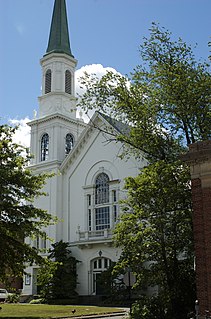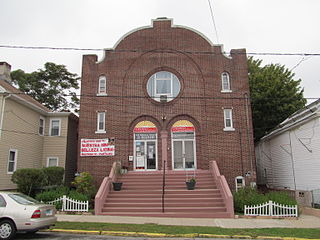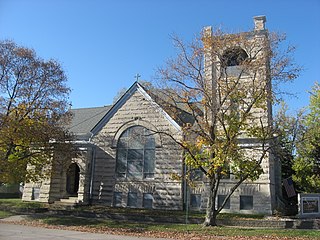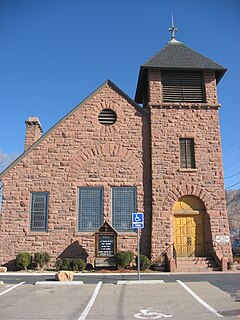
The Windsor Avenue Congregational Church is historic church at 2030 Main Street in Hartford, Connecticut. The brick Romanesque Revival-style church building, completed in 1872, now houses the Faith Congregational Church, whose lineage includes the city's oldest African-American congregation, established in 1819. The church is a stop on the Connecticut Freedom Trail and was listed on the United States National Register of Historic Places in 1993.

United Parish of Auburndale, formerly the Auburndale Congregational Church, is a historic church at 64 Hancock Street in the Auburndale village of Newton, Massachusetts. Built in 1857 for an 1850 congregation and repeatedly enlarged, it is a prominent regional example of Romanesque architecture in wood. It was added to the National Register of Historic Places on September 4, 1986.

Beth Israel Synagogue is a historic former Jewish synagogue building at 238 Columbia Street in Cambridge, Massachusetts. Built in 1901, it was the first and principal synagogue to serve the East Cambridge area, and is a fine local example of Romanesque architecture. Now converted into residential condominiums, it was listed on the National Register of Historic Places in 1982.

The Calvinistic Congregational Church is an historic church building located at 820 Main Street in Fitchburg, Massachusetts. In 1967, the congregation joined with the First United Methodist Church of Fitchburg to form a cooperative ministry called Faith United Parish. Built in 1896. the church was designed by architect Henry M. Francis, and is one of the city's finest examples of Richardsonian Romanesque architecture. It was added to the National Register of Historic Places in 1979. The current pastor is Rev. Jeff Conlon.

The First Congregational Church, now known as Trinity Church, is an historic church at 730 Main Street in Waltham, Massachusetts. The present church building, an architecturally distinctive blend of Romanesque and Georgian Revival styling, was built in 1870 for a congregation established in 1820. It was listed on the National Register of Historic Places in 1989.

The First Congregational Church is an historic church located at 1 Church Street in Stoneham, Massachusetts. Built in 1840, it is a fine local example of Greek Revival architecture, and is a landmark in the town center. It was listed on the National Register of Historic Places on April 13, 1984. The church is affiliated with the United Church of Christ; the current pastor is the Rev. Meredith Allen.

The First Congregational Church of East Haven is a historic church at 251 Main Street in East Haven, Connecticut. It was built in 1772-74 by George Lancraft, a local builder, and is one of Connecticut's few surviving pre-Revolutionary churches. It is also one of New England's oldest stone churches, preceded principally by King's Chapel in Boston, Massachusetts. The church was listed on the National Register of Historic Places in 1982. The congregation is affiliated with the United Church of Christ.

Tephereth Israel Synagogue is a synagogue at 76 Winter Street in downtown New Britain, Connecticut. The Orthodox congregation, founded in 1925, meets at a two-story brick temple with Colonial Revival and Renaissance features, designed by Hartford architect Adolf Feinberg and built in 1925. The building was listed on the National Register of Historic Places in 1995.

The Ohev Sholem Synagogue is a historic synagogue building at 109 Blinman Street in New London, Connecticut. Built in 1920, good example of the Classical Revival and Colonial Revival style applied to synagogue architecture. The building served a religious function until 1974, when it was sold to a Latino community organization. The building was listed on the National Register of Historic Places in 1995 for its architectural significance.

The Evangelical Baptist Church is a historic church building on Veterans Square in Laconia, New Hampshire, United States. Built in 1836 and extensively restyled in 1871, it is a fine 19th-century building, illustrating adaptive alterations made over time to reflect changing uses and tastes. The building was listed on the National Register of Historic Places in 1985. The building now houses a restaurant.

The First Congregational Church, United Church of Christ, also known as the New Old South Congregational Church, is a historic church at 235 Main Street in Farmington, Maine. The congregation's present sanctuary is a brick Romanesque structure designed by George M. Coombs and was completed in 1887. It is the town's finest 19th-century church, and one of the most architecturally sophisticated in the region. It was listed on the National Register of Historic Places in 1974. The congregation, established in 1814, celebrated its 200th anniversary in 2014.

The Fourth Congregational Church, also known historically as the Horace Bushnell Congregational Church and now as the Liberty Christian Center International, is a historic church at Albany Avenue and Vine Street in Hartford, Connecticut. The church building was built in 1913-14 using parts of an older Greek Revival church, and was listed on the National Register of Historic Places in 1982 for its architecture and role in local historical preservation efforts.

St. Paul's Methodist Episcopal Church, known more recently as the Templo Sion Pentecostal Church, is a historic church at 1886-1906 Park Street in Hartford, Connecticut, United States. Built in 1900, it is a good example of Romanesque Revival design. It was built for a working-class congregation to a design by the nationally known church architect George W. Kramer, proponent of the Akron plan of church interiors, which this one follows. The church was added to the National Register of Historic Places in 1984.

Temple Beth Israel is a historic Jewish synagogue building at 21 Charter Oak Avenue in Hartford, Connecticut. Built in 1875-76, it is the oldest purpose-built synagogue building in the state. The building was listed on the National Register of Historic Places in 1978. After being rescued from threatened demolition, it now houses a local cultural center. The congregation, established in 1843, is now located at a synagogue in West Hartford.

The South Congregational Church is a former Congregational and United Church of Christ church building complex located on the intersection of Court and President Streets in Carroll Gardens, Brooklyn, New York City. The complex consisting of a church, original chapel, ladies parlour and rectory was landmarked by the Landmarks Preservation Commission on March 23, 1983. It was listed on the National Register of Historic Places in 1982.

The Ahavas Sholem Synagogue, once known colloquially as The White Street Shul and now as the Thomas Hill Chapel, is a historic religious building at 30 White Street in New Haven, Connecticut. Built in 1928 for an Orthodox congregation founded in 1912, it is a distinctive example of a neighborhood synagogue with elaborate Classical Revival styling, for which it was listed on the National Register of Historic Places in 1995. The building is now home to Thomas Chapel, which is affiliated with the Church of Christ.

First Congregational Church is a historic Congregational church located at 202 N 6th Street in Marshall, Illinois. Built in 1909, the church was the third built for Marshall's First Congregation, which was established in 1841. The Gray Construction Company built the church in the Richardsonian Romanesque style. The church has limestone walls laid in alternating smooth and rusticated rows. The asymmetrical entrance features two arches supported by columns with ornamental floral capitals. The church has multiple stained glass windows, including a rose window on its front facade. A 56-foot (17 m) bell tower with square pillars at the upper corners marks the southeast corner of the building. The tower's bell, a relic from the original two churches, was made in 1850 by the Buckeye Bell Foundry of Cincinnati, Ohio.

The Old Stone Congregational Church, also known as the First Congregational Church of Lyons, is a historic church in Lyons, Colorado, built in 1894-5 and listed on the National Register of Historic Places in 1976.

Beth Hamedrash Hagodol Synagogue was an Orthodox Jewish congregation located at 370 Garden Street in Hartford, Connecticut. Founded in 1905, the congregation built the Romanesque temple on Garden Street in 1921–22. The congregation merged with the Ateres Kneset Israel congregation in 1962 to form the United Synagogue of Greater Hartford, and moved to new quarters in West Hartford. Its building, listed on the National Register of Historic Places for its architecture, is now home to the Greater Refuge Church of Christ.

Ahavas Shalom Reform Temple, also known as Trinity Assembly of God Church, is a historic synagogue located in Ligonier, Noble County, Indiana at 503 Main Street. It was built in 1889, and is a one-story, red brick building with Gothic Revival and Romanesque Revival style design elements,. It has a reek cross plan and is topped by a steep cross-gabled roof. It features an entrance tower topped by a steep pyramidal roof. In 1954, the building was sold to a Methodist congregation and now houses the Ligonier Historical Museum.

























